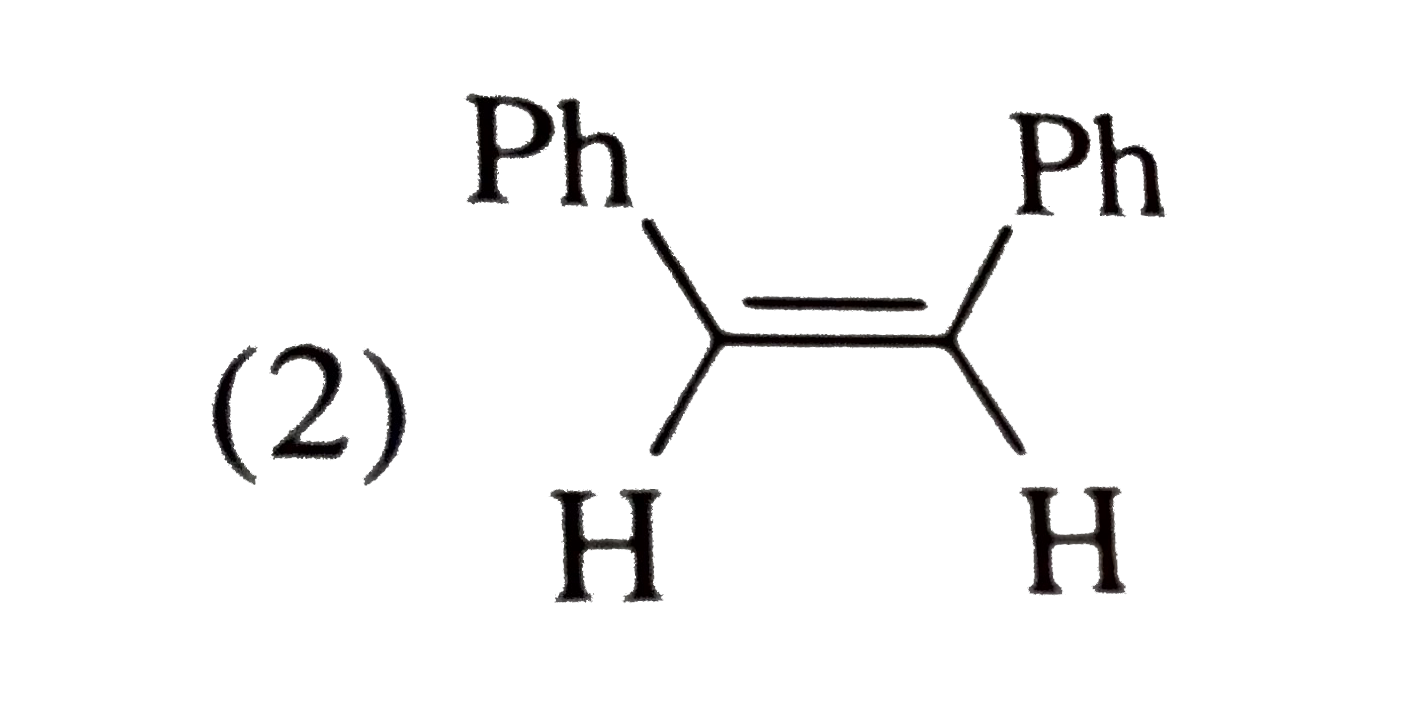Ph−CH=CH−PhCl2−−→CCl4X2NaNH2−−−−→YH2,Pd−CaCO3−−−−−−−−−→Z
Identify product (Z) of the reaction.


Ph−C∣Ph=CH2
Ph−C≡C−Ph
The correct Answer is:B
To solve the problem step by step, we will analyze the reaction sequence given in the question:
1. Starting Material: The starting material is Ph-CH=CH-Ph, which is a styrene derivative (a phenyl group attached to a vinyl group).
2. First Reaction (Addition of Cl2 in CCl4):
- The first reagent is Cl2 in the presence of CCl4. This is a halogenation reaction.
- When Cl2 is added to the alkene (Ph-CH=CH-Ph), it undergoes an electrophilic addition to form a dihaloalkane. The addition of Cl2 across the double bond occurs in a trans manner, resulting in the formation of 1,2-dichloro-1,2-diphenylethane.
- The product X can be represented as:
Ph-CH(Cl)-CH(Cl)-Ph
3. Second Reaction (Dehydrohalogenation with 2NaNH2):
- The next step involves the treatment of the product X with 2 moles of NaNH2. This reagent is a strong base and will induce dehydrohalogenation, which means it will remove the halogen atoms and a hydrogen atom from adjacent carbon atoms to form a triple bond.
- This reaction will convert the dihaloalkane into an alkyne (specifically, phenylacetylene).
- The product Y can be represented as:
Ph-C≡C-Ph
4. Third Reaction (Catalytic Hydrogenation with H2 and Pd-CaCO3):
- The final step involves the catalytic hydrogenation of the alkyne (Y) using H2 in the presence of palladium on calcium carbonate (Pd-CaCO3), which is known as Lindlar's catalyst.
- This catalyst allows for the partial hydrogenation of alkynes to form cis-alkenes. Therefore, the alkyne will be converted to a cis-alkene.
- The product Z can be represented as:
cis-Ph-CH=CH-Ph
5. Final Product: The final product Z is cis-stilbene (cis-1,2-diphenylethylene).
Summary of Products:
- X: 1,2-Dichloro-1,2-diphenylethane (Ph-CH(Cl)-CH(Cl)-Ph)
- Y: Phenylacetylene (Ph-C≡C-Ph)
- Z: cis-Stilbene (cis-Ph-CH=CH-Ph)
- The first reagent is Cl2 in the presence of CCl4. This is a halogenation reaction.
- When Cl2 is added to the alkene (Ph-CH=CH-Ph), it undergoes an electrophilic addition to form a dihaloalkane. The addition of Cl2 across the double bond occurs in a trans manner, resulting in the formation of 1,2-dichloro-1,2-diphenylethane.
- The product X can be represented as:
Ph-CH(Cl)-CH(Cl)-Ph
- The next step involves the treatment of the product X with 2 moles of NaNH2. This reagent is a strong base and will induce dehydrohalogenation, which means it will remove the halogen atoms and a hydrogen atom from adjacent carbon atoms to form a triple bond.
- This reaction will convert the dihaloalkane into an alkyne (specifically, phenylacetylene).
- The product Y can be represented as:
Ph-C≡C-Ph
- The final step involves the catalytic hydrogenation of the alkyne (Y) using H2 in the presence of palladium on calcium carbonate (Pd-CaCO3), which is known as Lindlar's catalyst.
- This catalyst allows for the partial hydrogenation of alkynes to form cis-alkenes. Therefore, the alkyne will be converted to a cis-alkene.
- The product Z can be represented as:
cis-Ph-CH=CH-Ph
- X: 1,2-Dichloro-1,2-diphenylethane (Ph-CH(Cl)-CH(Cl)-Ph)
- Y: Phenylacetylene (Ph-C≡C-Ph)
- Z: cis-Stilbene (cis-Ph-CH=CH-Ph)
Topper's Solved these Questions
Similar Questions
Knowledge Check
Ph−CH=CH−PhCl2−−→CCl4X2NaNH2−−−−→YH2,Pd−CaCO3−−−−−−−−−→Z
Identify product (Z) of the reaction.A B
B C
C DPh−C≡C−Ph
DPh−C≡C−Ph Br2−−→CCl4(i)alc. KOH−−−−−−−→(ii)NaNH2(A)major, Product (A) is :AH2C=CH−CH=CH2BCH3−C≡C−CH3CCH3−CH2−C≡CHDCH3−CH=C=CH2
Br2−−→CCl4(i)alc. KOH−−−−−−−→(ii)NaNH2(A)major, Product (A) is :AH2C=CH−CH=CH2BCH3−C≡C−CH3CCH3−CH2−C≡CHDCH3−CH=C=CH2Ph−Cl∣C∣Cl−CH33NaNH2−−−−→(A)Product, product (A) is :
APh−CH=CH2BPh−C≡CHCPh−CH2−CH3DPh−C≡ɵC⊕Na
ACl2−−→BAgCN−−−→C[H]−−→(CH3)2 NH Reactant [ A ] is :
View SolutionCH3CH2C≡CHNaNH2−−−−−→liq. NH3I

Product (K) of the above reaction is :
View SolutionPh−O∣∣C−CH3NaNO2−−−−→HCl(A)AC2O−−→heat(B)H3O+−−−→(C)
Product ( C) of the above reaction is :
View SolutionH3C−CH3∣C∣CH3−H+CCl4R2O2−−→hvProduct :
View SolutionCH3−CH=CH2Br2−−−−−−−−→h v (low conc.)Mg−−−−−→Dry etherCH3−O∣∣C−CH3−−−−−−−−−→NH4ClH+−−→Δ(X)(major)
End product (X) of the above reaction is :
View Solution
